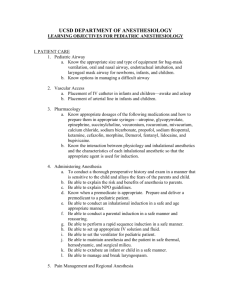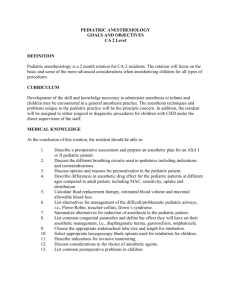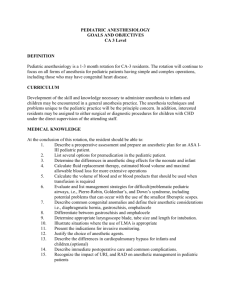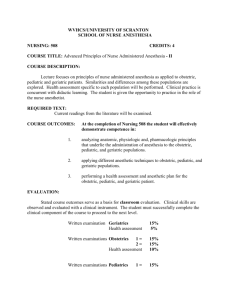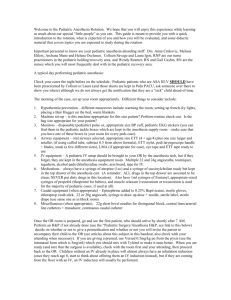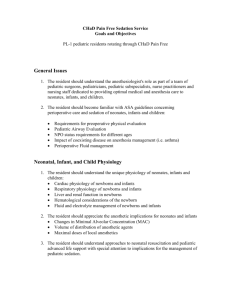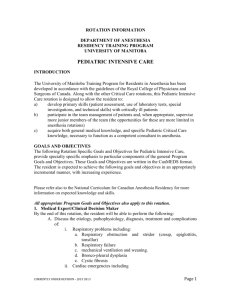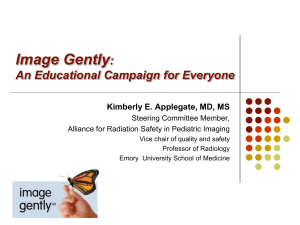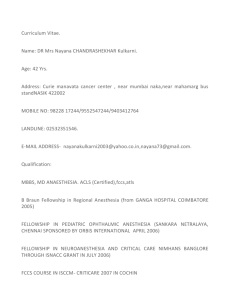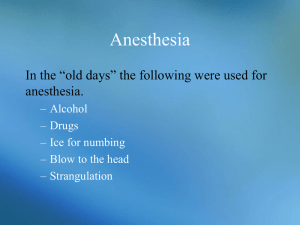- 6th Anesthesia & Critical Care Conference
advertisement
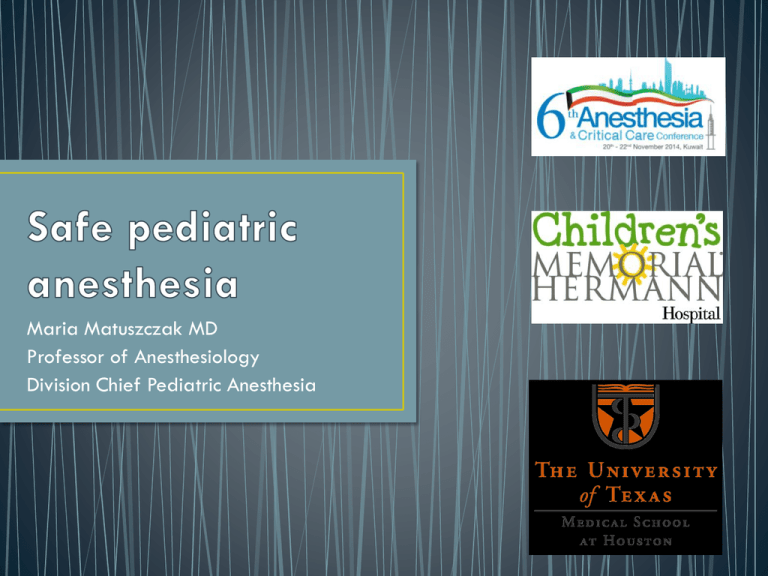
Maria Matuszczak MD Professor of Anesthesiology Division Chief Pediatric Anesthesia Nothing to disclose Objectives Part 1 The preoperative assessment Preparation of the operating room The checklist Crisis management Post anesthesia care Importance of communication Team building Simulation Objectives Part 2 Neurotoxicity and developing brain Wake-up safe PRAN Pediatric Difficult Airway Registry The preoperative assessment Preparation of the operating room How safe is Healthcare Deaths due to medical errors = 8th cause of death. Deaths due to medical errors > motor vehicle accidents, breast cancer or AIDS Medication errors alone = 7,000 deaths annually Healthcare-associated infections =100,000 deaths Total national costs of preventable adverse events are estimated to be between $17 - $29 billion Patient safety topics on the WHO website Patient safety resources are categorised using these topic headings: Abuse/aggression and patient safety Consent, communication, confidentiality Documentation and patient safety (checklists/patient records) Environment and patient safety (cleaning, PEAT) Human factors and patient safety culture (Seven Steps, teamwork, staffing) Medical devices/equipment Medication safety Patient accident (slips, trips and falls) Patient admission, transfer, discharge (patient ID) Patient assessment and diagnosis (tests, scans) Patient treatment/procedure (nutrition) Risk assessment and patient safety The checklist Gawande A. The checklist manifesto: how to get things right. New York: Metropolitan Books, 2010. The checklist 14 cases of wrong-side thoracenteses are identified. Contributing factors: failure to perform a time-out (n=12), missing indication of laterality on the patient’s consent form (n=10), absence of a site mark on the patient’s skin , absent verification of medical images (n=7). Complications included: pneumothoraces (n=4), hemorrhage (n=3), and death directly attributable to the wrong-side thoracentesis (n=2). Teamwork and communication failure, unawareness of existing policy, and a deficit in training and education were the most common root causes of wrong-side thoracentesis. Crisis management SPA’s Pediatric Critical Events Checklists are freely available on the SPA website at http://www.pedsanesthesia.org/newnews/Critical_Event_Checklists.pdf. Crisis management Arriaga AF, Bader AM, Wong JM, et al. Simulation-Based Trial of Surgical-Crisis Checklists. N Engl J Med 2013; 368: 245-53. Post-Anesthesia Care Unit Importance of communication/handoffs Culture of safety Team building Awareness Simulation Objectives Part 2 Neurotoxicity and developing brain Wake-up safe PRAN Pediatric Difficult Airway Registry Neurotoxicity and developing brain Consensus Statement on the Use of Anesthetics and Sedatives in Children December 2012 Each year, millions of young children require surgery and other procedures for serious or life-threatening medical conditions or to improve their quality of life. Anesthetic and sedative drugs are widely used to help ensure the safety, health, and comfort of children undergoing these procedures. However, increasing evidence from research studies suggests the benefits of these agents should be considered in the context of their potential to cause harmful effects. Previous research in young animals and children has raised concerns that exposure to commonly used anesthetics may produce adverse neurobehavioral effects. However, these studies had limitations that prevent experts from drawing conclusions on whether the harmful effects were due to the anesthesia or to other factors, including surgery, hospitalization, or pre-existing conditions. Furthermore, the findings in children have been mixed, with some studies of infants and young children undergoing anesthesia or sedation finding long-term deficits in learning and behavior while others have not. Clearly, additional research is urgently needed to identify any possible risks to young children. In the absence of conclusive evidence, it would be unethical to withhold sedation and anesthesia when necessary. Instead, healthcare providers should do the following: Discuss with parents and other caretakers the risks and benefits of procedures requiring anesthetics or sedatives, as well as the known health risks of not treating certain conditions Stay informed of new developments in this area Recognize that current anesthetics and sedatives are necessary for infants and children who require surgery or other painful and stressful procedures Wake-up safe The Goals of Wake up Safe are: To define quality in pediatric anesthesia care. To develop ways of measuring quality in pediatric anesthesia care. To develop robust Quality Improvement Systems within Departments of Pediatric Anesthesia. To provide data to allow research about adverse events in pediatric perioperative care. The Objectives of Wake up Safe are: To develop a registry of adverse events in pediatric perioperative care. To analyze adverse events and to determine common causes for these adverse events. To devise strategies to prevent adverse events. To gather data to allow departments to compare their data with national norms. PRAN Pediatric regional anesthesia network December 2012; 115(6) 1352-64 14,917 RA, performed on 13,725 patients, from April 1, 2007 through March 31, 2010. No deaths or complications with sequelae lasting >3 months (95% CI 0–2:10,000). 95% of blocks placed while patients were under GA. Widespread use of ultrasound (83% of upper extremity and 69% of lower extremity blocks). Pediatric Difficult Airway Registry Conclusion
